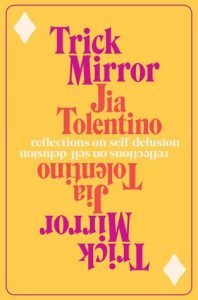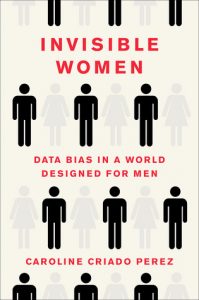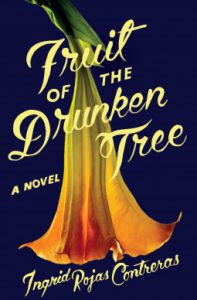 There’s something oddly satisfying reading an essay without a clear and conclusive ending – it’s as though we’re able to watch as the writer makes their way through the question, wading in and trying to figure it out, only to end up mired in all the muck but at least better able to see the muck in which they are stuck. It’s not necessarily a feeling of despair that this inconclusiveness dregs up, so much as the feeling that the journey itself is well worth the effort, that knowing what mess you’re in is half the battle. Part of me is so used to having essays and articles wrap up neatly, tell me how to fix the issue, what I can do to become part of the solution, that it’s almost refreshing to see that sometimes we don’t have all the answers yet, and there’s maybe no “right” way the author can provide me. And that’s how I feel about Trick Mirror by Jia Tolentino, which is an absolute delight to read, though frustrating at times precisely because while Tolentino picks apart social issues, she doesn’t necessarily give it back to us in one piece, or put back together in any way. Now don’t get me wrong, I’m not saying this detracts from the delight I get from the essays, at all: it makes them shine even brighter.
There’s something oddly satisfying reading an essay without a clear and conclusive ending – it’s as though we’re able to watch as the writer makes their way through the question, wading in and trying to figure it out, only to end up mired in all the muck but at least better able to see the muck in which they are stuck. It’s not necessarily a feeling of despair that this inconclusiveness dregs up, so much as the feeling that the journey itself is well worth the effort, that knowing what mess you’re in is half the battle. Part of me is so used to having essays and articles wrap up neatly, tell me how to fix the issue, what I can do to become part of the solution, that it’s almost refreshing to see that sometimes we don’t have all the answers yet, and there’s maybe no “right” way the author can provide me. And that’s how I feel about Trick Mirror by Jia Tolentino, which is an absolute delight to read, though frustrating at times precisely because while Tolentino picks apart social issues, she doesn’t necessarily give it back to us in one piece, or put back together in any way. Now don’t get me wrong, I’m not saying this detracts from the delight I get from the essays, at all: it makes them shine even brighter.
Shortly after reading Trick Mirror, a Buzzfeed article published earlier this year ended up in my feeds: How Millennials Became the Burnout Generation by Anne Helen Peterson, on the relationship between millennials and burnout. As I was reading, I couldn’t help but notice how well it complemented one of the essays in Trick Mirror: Always Be Optimizing. Whereas Always Be Optimizing discusses the ways in which women, buying into a commodified feminism*, end up swallowed by the “ideal woman” they strive to become and entering into a cycle of trying to win the game that is the systemic oppression of women, The Burnout Generation talks about a similar phenomenon where constant self-optimization in every area of their lives, including – or perhaps especially in the realm of – self-care, has given millennials burnout**.
What I find particularly interesting is that in both of these pieces, as I mention above, a clear-cut solution is not available for our neat consumption at their conclusions: both Tolentino and Peterson recognize the system and the ways in which it is unhealthy and exploitative, and yet… both of them remain fairly stuck in the roles they explore in their writing. Which I think is actually fairly representative of the way in which many of us who consider ourselves to be well informed or critical of the society in which we live, continue to live within the framework. For Tolentino, the solution would be “to follow the cyborg… to be willing to be disloyal, to undermine. The cyborg is powerful because she grasps the potential in her own artificiality, because she accepts without question how deeply it is embedded in her”, but all the iterations Tolentino cites of this cyborg (e.g. Her, Morgan, Ex Machina, etc.) end when the female cyborgs kill their (male) creators, which isn’t toooo helpful as far as giving us a framework of what life could look like after upending the current system***. And Tolentino recognizes this, too:
It’s possible if we want it. But what do we want? What would you want – what desires, what forms of insubordination, would you be able to access – if you had succeeded in becoming an ideal woman, gratified and beloved, proof of the efficiency of a system that magnifies and diminishes you every day?
It’s hard to even know what exactly it is that you want if you try to remove what society pushes your way and tells you you’re supposed to enjoy (and what if a woman actually enjoys doing the housework, cleaning, looking “pretty” according to the standards society has set forth in spectacularly narrow terms? How would you even know?).**** This nebulous and inchoate future remains beyond our grasp, and it’s actually somewhat comforting after Tolentino criticizes the systematic branding and commodification of women’s self-care (by which I’m referring not to the bougie Self-Care but actual caring of one’s self in the form of minding one’s health & general well-being), because it’d be almost a bit suspect if she had neatly packaged a cure to sell to women (in another meta participation in the endless cycle she is at the same time critical of and cognizant of being a part of).
On the other hand (or perhaps on the same hand), Peterson concludes: “I don’t have a plan of action, other than to be more honest with myself about what I am and am not doing and why, and to try to disentangle myself from the idea that everything good is bad and everything bad is good”, which, sure, but isn’t really much of a solution to the reader who already knows this. It’s frustrating, but I feel like the acknowledgement of these questions is already an improvement: if we can name it, we can address it and see how to move forward by becoming able to refer to it in a consistent manner.*~ And so with many of the essays in Trick Mirror, where solutions are vague if at all outlined, and the journey of exploring a question is the main purpose of the essay. It’s an essay in the style of Montaigne, in a way – un essai, a try, a probing of a subject.

